Traditional Thai Salutation
Back to Articles about Thai Culture
- During a visit to the Thai Buddhist temple in Washington D.C., I was asked to post some short articles about the various aspects of Thai culture into the Thaimyway page. A number of subjects were mentioned at that meeting. And here is one of them : The Traditional Thai Salutation. - Chakrarot.
Many Asian cultures share the same gesture of greeting - the putting together of hands at chest level. Thai people use several modes of this gesture in salutation, each mode suiting a particular purpose. Each person learns to use the proper gesture for the purpose it is intended for from early childhood. He is trained to do so until the knowledge becomes a second nature. The variety is such that a foreigner who attempts to conform, with all good intentions, may seem awkward to the native Thai.
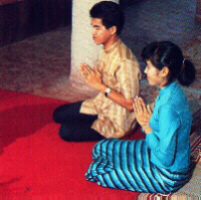
Putting the palms of one's hands together at chest level is not actually a greeting, but is a gesture of veneration known as “panom mue”. It is used to pay respects to venerated objects and people such as Buddha images, Buddhist monks, the royalty, etc.
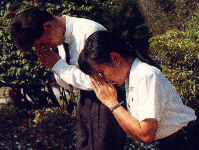 The “panom mue”
becomes a “wai” salutation only when the hands are brought up from chest
level to face level. The higher they are placed in front of the face,
accompanied by increasingly deep bending of the head forward, indicates the
degree of respect. Basically, the degree or gradation depends on social standing
or seniority. For example, a younger person will initiate a “wai” to be
responded by a similar gesture from the older person. By etiquette, the younger
person bows his head a little more than does the older person, and a layman will
“wai” a Buddhist monk without consideration of age.
The “panom mue”
becomes a “wai” salutation only when the hands are brought up from chest
level to face level. The higher they are placed in front of the face,
accompanied by increasingly deep bending of the head forward, indicates the
degree of respect. Basically, the degree or gradation depends on social standing
or seniority. For example, a younger person will initiate a “wai” to be
responded by a similar gesture from the older person. By etiquette, the younger
person bows his head a little more than does the older person, and a layman will
“wai” a Buddhist monk without consideration of age.
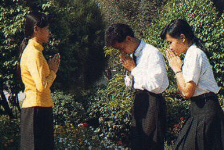 The solicited
response is of interest. Sometimes etiquette demands that the older person
responds by neither raising his hands nor bowing his head and remains in the
attitude of “panom mue” only. Generally, it is rude not to respond to a
greeting with the exception that Buddhist monks never physically respond to
salutations by the layman.
The solicited
response is of interest. Sometimes etiquette demands that the older person
responds by neither raising his hands nor bowing his head and remains in the
attitude of “panom mue” only. Generally, it is rude not to respond to a
greeting with the exception that Buddhist monks never physically respond to
salutations by the layman.
As the “wai” becomes more respectful and the head bends further forward, the whole body may also be lowered until the person who is making the gesture of salutation actually sits on the floor and places his hands, still with palms together, on the floor. This posture is known as the “krab” .
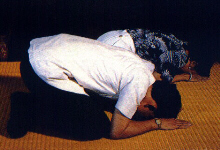 There are two
different styles of sitting in salutation : the formal “benchangapradit”
style and the “pubpiab” (“half prostration”) style. The
“benchangapradit” style is used to venerate the “triple gems” of
Buddhism i.e. the Lord Buddha, his Dharma teachings, and the Sangkha order of
monks. The name derives from the fact that five (bencha) bodily extremities :
the forehead, both hands and knees, are profferred on the ground to the worship
of Buddhism. In action, the person sits upright on his haunches. He performs the
“panom mue”, brings the hands up to his face to “wai” while bending the
whole body forward to “krab” on the floor.
There are two
different styles of sitting in salutation : the formal “benchangapradit”
style and the “pubpiab” (“half prostration”) style. The
“benchangapradit” style is used to venerate the “triple gems” of
Buddhism i.e. the Lord Buddha, his Dharma teachings, and the Sangkha order of
monks. The name derives from the fact that five (bencha) bodily extremities :
the forehead, both hands and knees, are profferred on the ground to the worship
of Buddhism. In action, the person sits upright on his haunches. He performs the
“panom mue”, brings the hands up to his face to “wai” while bending the
whole body forward to “krab” on the floor. 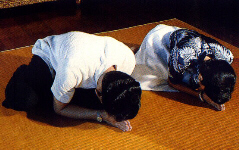 The
palms are actually placed flat on the floor and the forehead touches the floor
between them. The process is always repeated three times. To “krab” highly
respected people such as members of the royalty, the other seated attitude
“pubpiab” is used. Here the person sits on the floor with both legs folded
to one side of the body. He bends the torso forward and places both hands on the
floor. In this case, however, the hands maintain the “panom mue” attitude on
the floor.
The
palms are actually placed flat on the floor and the forehead touches the floor
between them. The process is always repeated three times. To “krab” highly
respected people such as members of the royalty, the other seated attitude
“pubpiab” is used. Here the person sits on the floor with both legs folded
to one side of the body. He bends the torso forward and places both hands on the
floor. In this case, however, the hands maintain the “panom mue” attitude on
the floor.
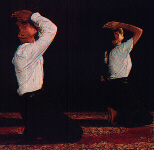 The final
salutation is the one which displays the deepest respect of all. It is known in
Thai as “tawai bangkhom” and is reserved for the King. The person who
performs this traditional salutation sits on his heels, knees on the floor. He
puts his hands together in the basic “panom mue” attitude, sways the torso
to the front while bringing the hands up in a sweeping gesture to a position
high on the forehead. At the pinnacle of the hand sweep, the neck is bent
backward to its furthest extent. After that, the hands are lowered to chest
level and the process repeated twice more. This extreme salutation may be
witnessed at the public display of veneration of King Rama V on the anniversary
of his death on 23 October at the memorial statue in Bangkok.
The final
salutation is the one which displays the deepest respect of all. It is known in
Thai as “tawai bangkhom” and is reserved for the King. The person who
performs this traditional salutation sits on his heels, knees on the floor. He
puts his hands together in the basic “panom mue” attitude, sways the torso
to the front while bringing the hands up in a sweeping gesture to a position
high on the forehead. At the pinnacle of the hand sweep, the neck is bent
backward to its furthest extent. After that, the hands are lowered to chest
level and the process repeated twice more. This extreme salutation may be
witnessed at the public display of veneration of King Rama V on the anniversary
of his death on 23 October at the memorial statue in Bangkok.
- Photographs : THAI ETIQUETTE a publication of the Office of the National Culture Commission (free distribution).
Back to Articles about Thai Culture
Search for books about Thai Culture and Thai Puppetry
|
||||||